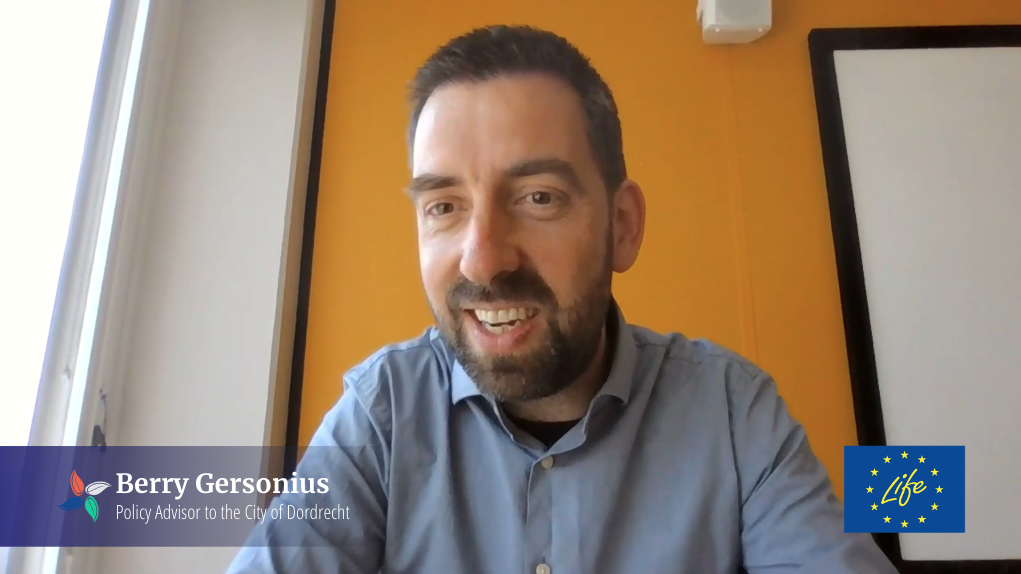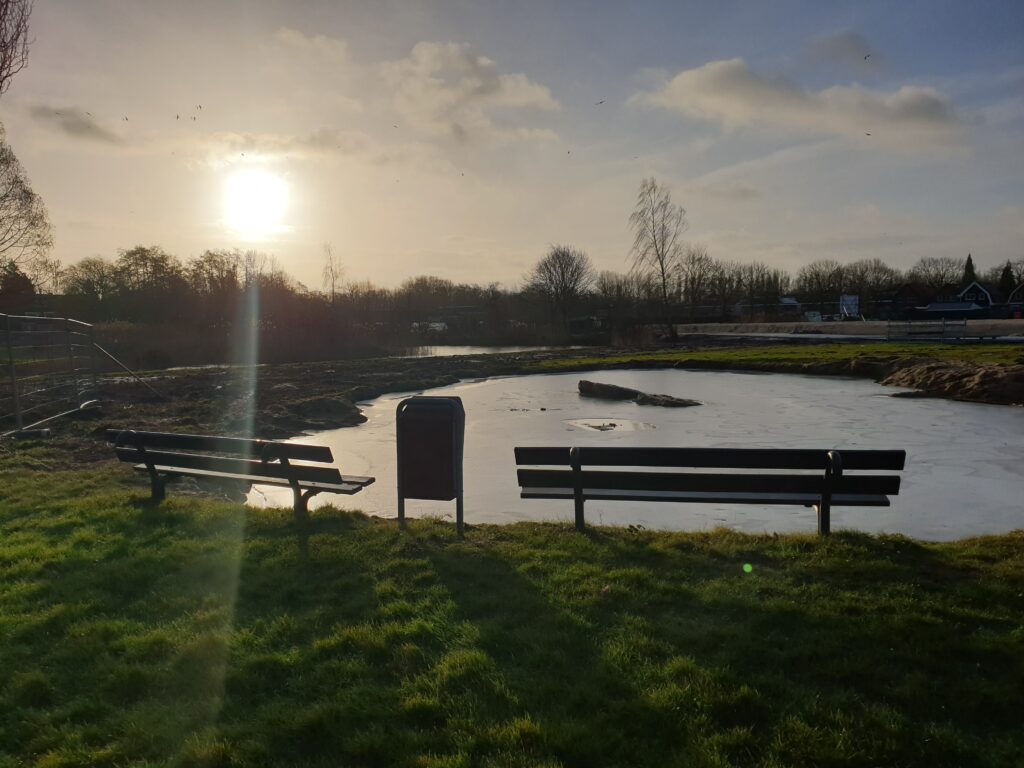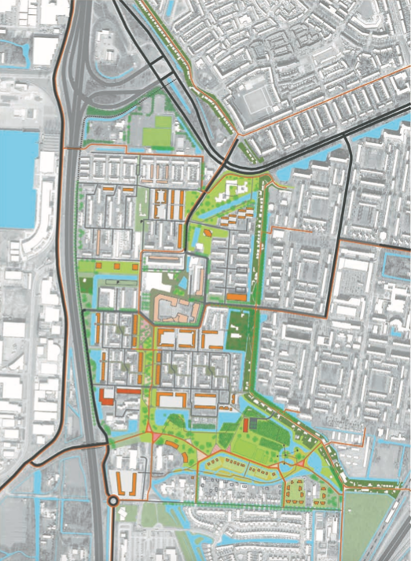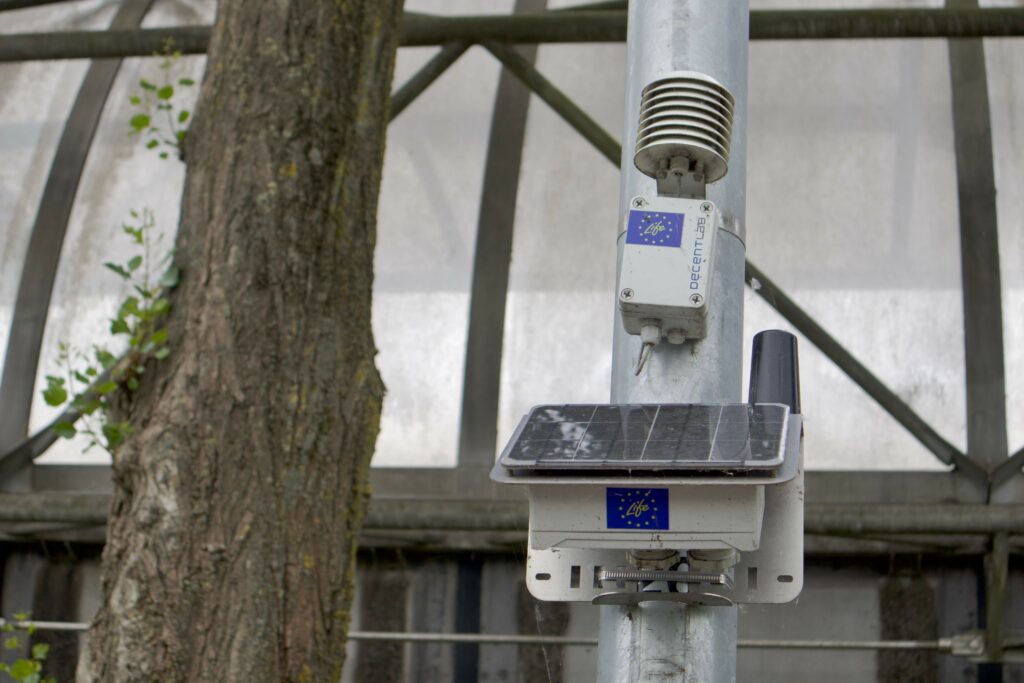Replicating Success: Strategies for Climate Adaptation Initiatives
Berry Gersonius is a policy advisor to the City of Dordrecht for their Blue Green City initiative. He works at the intersection of knowledge, policy making and learning for effective adaptation. In this interview he spotlights the importance of climate adaptation and the role replication and knowledge sharing play in these initiatives.
Tell us a bit about yourself and your work?
My name is Berry, and I work for the City of Dordrecht. As a policy advisor, my primary focus is on the Blue Green City initiative, a top-tier priority for our municipality. This priority centres on climate adaptation, biodiversity conservation, and also improving the well-being of our fellow residents. Through nature-based solutions (NbS) and urban management that promotes cycling and walking, we are working to pave the way to a healthier and happier urban existence.

Why is climate adaptation such a crucial part of urban design?
Climate adaptation isn’t just an item on the urban design checklist; it’s at the core of our city’s spatial and environmental vision. In Dordrecht, this vision sets the stage for all our urban planning endeavours, outlining seven to nine key priorities. Climate adaptation, naturally, is right up there on the list, alongside biodiversity and promoting healthier living. These priorities serve as our guiding principles in every urban project we undertake, shaping our city into a resilient, vibrant, and ultimately, more liveable urban environment.
Why are you pursuing climate adaptation in Wielwijk?
We’ve set our sights on climate adaptation in Wielwijk for a number of reasons, primarily centred around its unique geographic and demographic position. Demographically, Wielwijk stands as a socially vulnerable neighbourhood. This is significant because research in the Netherlands and elsewhere has shown that socially vulnerable individuals and communities are often the most vulnerable to the impacts of climate change. Their homes and living environments are frequently ill-equipped to handle the challenges posed by the climate crisis, and they often lack the financial means to take proactive adaptation measures.
The concern here is that if we don’t actively engage and intervene in these vulnerable areas, we risk leaving behind low-income residents and a significant portion of the middle class. They could find themselves stuck in inadequate housing that experiences extreme heat stress or is susceptible to flooding, with limited means to improve their situation. So, neighbourhoods like Wielwijk become the frontlines for climate adaptation and resilience. This is where the most pronounced effects of climate change are often felt.

What climate adaptation solutions are you pursuing in the area?
In Wielwijk, our focus has been on leveraging the park’s important position in our climate adaptation strategy. The park faces a unique vulnerability to flooding, especially during prolonged rainfall events. It’s not just about sudden cloudbursts; these extended periods of rainfall can lead to significant water accumulation, affecting the park’s vegetation.
To address this, we’ve begun a park redesign, carefully considering the park’s topography. We strategically created height variations within the park, determining optimal locations for various functions. Vulnerable functions are placed in higher areas, while nature-related elements that can coexist with occasional water issues are in lower-lying areas. This dynamic approach enhances the park’s climate resilience.

But our efforts go beyond the park’s boundaries – we’ve considered the park’s significance for the neighbourhood as a whole. The main access roads, which once ran through the middle of the neighbourhood, have been relocated to the periphery. In their place, the park has been extended into the neighbourhood, forming a central green corridor that stretches through the neighbourhood’s core.
This transformation was a response to the requests of the residents themselves. Now, at the heart of the neighbourhood, there’s a green artery connecting directly to the park. This design brings the park into the neighbourhood, creating a cooling effect during hot days and improving air quality. The relocation of cars to the outskirts of the neighbourhood further enhances the appeal of outdoor activities like walking to the nearby shopping centre. We’re striving for a community that predominantly chooses walking or cycling when heading to the shops, and the green corridor plays a vital role in achieving this goal.
Over the years, we’ve witnessed changes in participation levels. Some of it may be attributed to a lack of engagement, partly stemming from the demolition of parts of the neighbourhood and the influx of new residents, particularly along the green corridor. Engaging newcomers can be challenging when you don’t yet know who they are.
However, we’ve made efforts to involve new residents from the very beginning, even when they were in the process of buying their homes. For instance, we’ve developed example garden designs, offering a brochure with three reference designs that incorporate various levels of greenery. Residents can choose the design that best aligns with their preferences, and we provide guidance on how to implement these designs. This helps bridge the gap between front gardens and the green corridor.
Nevertheless, we’ve encountered resistance, with some individuals still opting for paved gardens. Shifting mindsets requires time and care, and we’re taking a promising step forward with the citizen science side of the project. We’re actively involving citizens in our monitoring program, focusing on heat stress in public spaces and private gardens. This hands-on experience allows residents to witness the benefits of greening firsthand, and we hope it will lead to a broader shift in mindset towards the advantages of embracing green solutions.
When working on climate adaptation in a new space, which parts of your work (both adaptation and monitoring) are done from scratch vs. replicated or adapted from previous work? Under what circumstances is replication best to explore?
Replication is an essential aspect of our approach to climate adaptation. The project we executed in Wielwijk, creating the green corridor linking the neighbourhood to the park, has become a benchmark for our climate adaptation endeavours. It’s safe to say that Wielwijk has become a trendsetter in this regard.
Our first replication effort took place in the Vogelbuurt, another socially vulnerable neighbourhood. Here, we aimed to replicate the concepts from Wielwijk, establishing a green connection to the neighbourhood park. However, the circumstances in Vogelbuurt were notably different. In Vogelbuurt, we not only had to create the green connection but also the entire neighbourhood park itself. The layout of Vogelbuurt presented challenges; it has narrow streets with small front gardens and extensive underground infrastructure. This made it virtually impossible to replicate the same kind of green corridor we established in Wielwijk.
In Vogelbuurt, the focus had to shift toward the front gardens, despite their limited size. This required engaging with a social NGO to act as intermediaries between us and the residents. The NGO helped convey the importance of greening their front gardens and provided residents with the necessary trees to do so. In the end, we succeeded in achieving our goal in Vogelbuurt, but it taught us a valuable lesson: replication of climate adaptation measures isn’t a one-size-fits-all endeavour. Each neighbourhood’s specific circumstances demand tailored solutions.
However, Wielwijk’s success remains a guiding light. We’ve since taken the lessons learned from Wielwijk and applied them in other neighbourhoods, such as Krispijn, where we’re implementing similar concepts. While replication may require adjustments to fit unique circumstances, having a successful model like Wielwijk to draw from is invaluable in our ongoing efforts to build climate resilience across various communities.
We’re curious to know more about this solution being replicated from a previous EU-funded project, SCORE’s Crowdscan – how did this solution come about, and why did you decide to expand its use to LIFE CRITICAL?
Dordrecht participated in the SCORE project, which aimed to increase efficiency and quality of public services in cities through smart and open data-driven solutions. As a replication partner in this project, we didn’t develop our own smart solutions, but instead, we had the opportunity to replicate innovative solutions developed by larger municipalities that had the capacity for such development. One particular solution emerged as a valuable tool for our work in Dordrecht: Crowdscan.
Our decision to implement Crowdscan and similar solutions in Dordrecht came after a careful analysis to identify which SCORE project solutions were most promising for our city. We focused on solutions that could address a specific challenge we were facing – the greening of the city.
Dordrecht was part of a subgroup within the SCORE project, where several cities were working on smart city parks. This subgroup explored solutions related to air quality and recreational aspects within parks. In our case, we applied solutions to monitor park visitation. Crowdscan uses sensors that could count the number of park visitors in a privacy-friendly manner. These sensors utilised radio magnetic signals, which were affected by the water within human bodies. This disturbance in the signal allowed us to measure the number of people in a large area like a park. Unlike cameras, which work well in streets but not in parks, Crowdscan proved effective in our park environment.
We successfully used Crowdscan to gain insights into park visitor numbers over a three-month period. Simultaneously, we conducted a QR code survey, informing people about our crowd flow monitoring efforts and inviting them to participate in a survey about their perception of the park, why they visited it, and how often they frequented it. This combination of quantitative data from the sensors and qualitative data from the survey provided us with a comprehensive understanding of park usage and visitor perceptions.
QR code engagement was a vital component of our approach. It helped us gauge the receptiveness of residents to such solutions. We selected Stanborough Park for this initiative because recent climate adaptation improvements had been implemented there. Our goal was to determine if we could replicate the same solutions in other locations where we still needed to implement them, such as Wielwijk Park.
From the outset of our tests in Stanborough Park, we had replication in mind. The project in Stanborough Park spanned a relatively short duration of three months, designed to test the solutions and assess their feasibility for replication elsewhere in Dordrecht, including Wielwijk Park and the new city park under development.
What’s particularly interesting is the potential to combine data from different sensors, such as climate change effects, climate adaptation measures, park usage, and visitor experiences. This integrated approach allows us to gain a more holistic view and uncover relationships between these data sets. For example, we can examine whether people are more inclined to visit areas with more shade during hot days, and if this pattern changes during cooler weather. Understanding these relationships can inform urban design decisions, potentially leading to different design principles and adaptations based on data-driven insights.
How do you address privacy issues of monitoring through solutions like Crowdscan?
Privacy is a paramount concern when it comes to monitoring solutions like Crowdscan. We take this issue very seriously. In some instances, we have unfortunately encountered vandalism in locations where we’ve deployed sensors, including Wielwijk Park. Incidents involved individuals tampering with the sensors or removing them from their locations, disrupting the measurement installations. While the sensors themselves weren’t damaged, this interference affected data collection.
To ease concerns and raise awareness about the privacy features of these sensors, we installed information billboards. These billboards explain the purpose of our monitoring efforts, why we’re conducting them, and emphasise the high level of privacy protection (110% privacy proof) built into the technology. The goal was to address any privacy concerns and reassure residents that their data was being handled responsibly.
Despite our efforts to inform and provide transparency, vandalism incidents persisted, suggesting that those who engaged in such activities had motivations beyond privacy concerns.
The issue of privacy also led us to reconsider monitoring efforts in other areas, like the city centre. In the past, we conducted measurements using different technology, such as Wi-Fi signals or cameras. However, these methods were found to be lacking in privacy protection, which prompted us to discontinue those measurements. We are currently exploring the possibility of using sensors similar to those used in Stanborough Park in the city centre, as these sensors offer a higher level of privacy protection, aligning with our commitment to safeguarding individuals’ privacy while collecting valuable data for urban planning and climate adaptation purposes.
In addition to making climate adaptive changes in the park, and working with citizen science and monitoring of environmental indicators, the solutions that you have been involved in are also designed to monitor or assess how the park and new green spaces are being used and perceived. Why is this important information to gather and how are you doing this?
Monitoring the usage and perception of parks and green spaces is of immense importance in our work. There’s a distinction between the measurements we conduct in public spaces, which indeed help us understand the effects of our climate adaptation measures. This data is instrumental in refining our design choices and even in persuading our colleagues of the benefits and necessity of climate adaptation. Internal resistance can be a challenge at times, and having concrete evidence of the effectiveness of our initiatives helps reinforce the message.
In municipalities, including ours, there’s often a tendency to invest in projects and then move on to the next priority without much consideration for ongoing monitoring and evaluation. Unlike businesses, where accountability and demonstrating the impact of measures are integral, municipal cultures tend to prioritise ambitions and future plans over post-implementation evaluation. This cultural difference underscores the need for a shift in how municipalities approach monitoring and the assessment of measure effectiveness.
That’s where citizen science comes into play. It’s not just about gathering data; it’s also about creating awareness and potentially driving a change in attitude. While those who participate in our monitoring campaigns are likely already aware and receptive to the message of climate adaptation, they play a crucial role in spreading that awareness further. They become ambassadors for climate adaptation and greening within their communities, as they have better relationships and more credibility among their neighbours than the municipality does.

The power of citizen engagement lies in the community aspect. It’s not just about hearing the message from the municipality; it’s about hearing it from your neighbour and fellow community members. This kind of grassroots awareness-building can be much more convincing and has the potential to foster a network of like-minded individuals who share the goal of enhancing climate resilience and green initiatives in their neighbourhoods. Currently, we have 25 people engaged in Wielwijk, and they are all ambassadors for climate adaptation and greening, contributing significantly to the cause.
If someone tuning into this wanted to set up a climate adaptation initiative in their city, what advice would you give them?
If someone were to embark on such a journey, here’s the advice I’d offer:
Firstly, when it comes to citizen science, having an intermediary is crucial. This intermediary should have the specific skills necessary for effective engagement with citizens, skills that municipalities often lack. Additionally, having this intermediary in place can create a more neutral position between the municipality and the residents. In our case, it has proven highly beneficial to work with such intermediaries because they bring a degree of detachment, making it easier for the municipality to engage with citizens. Without this intermediary, we found it challenging to make significant progress in citizen science initiatives.
Secondly, it’s essential to understand that citizen science is not a volunteer job with a set job description. Participants won’t necessarily do what you want them to do; they’ll prioritise their own interests and initiatives. Therefore, you need to allow room for their autonomy and creativity. They decide what interests them and when and how they want to monitor. Flexibility in accommodating their preferences is key to a successful citizen science project.
Regarding climate adaptation, my advice is that there are numerous angles to explore. It’s essential to connect climate adaptation with other topics such as biodiversity and improving the living environment. When engaging with citizens, focus on improving the environment and greening neighbourhoods rather than just adapting to climate change. Climate adaptation should be part of a more comprehensive ambition to enhance the city’s overall quality, making it a more attractive, sustainable, and resilient place to live.
With the impacts of the climate crisis becoming more tangible each year (through floods, droughts, wildfires, and other extreme weather events for example) how do you see monitoring fitting into the solutions?
Monitoring plays a multifaceted role in addressing the impacts of the climate crisis. Firstly, it serves as a tool to demonstrate the value of investing in climate adaptation. As the tangible impacts of climate change, such as floods, droughts, wildfires, and extreme weather events, become more apparent, monitoring helps showcase how these investments contribute to a more livable city. For instance, by lowering temperatures through green initiatives or other adaptation measures, we can create a more comfortable and resilient urban environment. This demonstration of real-world benefits not only builds political support but also generates social support. Citizen science, in particular, plays a vital role in fostering this social support, as participants can serve as advocates who spread the message to their families, friends, and neighbours.
Moreover, monitoring serves as an essential tool for municipalities like ours to gauge whether we are on the right track in terms of climate adaptation efforts. We need to assess whether we are moving in the right direction and whether we are making progress at a pace that aligns with our climate adaptation goals. This aspect of monitoring progress is becoming increasingly important as we strive to effectively combat the climate crisis and ensure the sustainability and resilience of our cities.
Curious to learn more about the intersection between citizens science and climate adaptation? Get in touch!
